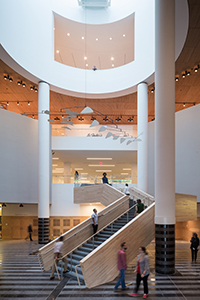

San Francisco Museum of Modern Art, The New Cultural Center Of The City
Photo Courtesy of Henrik Kam, courtesy of SFMOMA
Walk up the stairs to the new Howard Street entrance of the completely remodeled San Francisco Museum of Modern Art (SFMOMA) and you may feel as if you’ve entered one of the city’s tech company offices instead of an art museum. The floor is a glossy gray and the space is open, airy and filled with light. Floor-to-ceiling windows are everywhere. The place is expansive, to the tune of 170,000 square feet of gallery space. (For comparison, New York City’s MOMA offers 125,000 square feet.) It’s sleek with a hint of sexiness. And it smells new.
Turn your head and you’ll quickly realize it is, in fact, a wildly modern museum. Look down from your position at the entrance and, to the left, you’ll spot a tan wooden amphitheater surrounding half of Richard Serra’s Sequence, a 214-ton, circular steel structure.

Stairway to Artistic Heaven, Photo Courtesy of Iwan Baan, courtesy of SFMOMA
When you look up and to the right, you’ll see a swirling blue and white mural, Sol LeWitt’s Wall Drawing 895: Loopy Doopy (white and blue). Walk up the stairs flanking the lobby to the third floor, which is devoted to photography and an outdoor terrace that houses the living wall, a 29-foot-tall, 150-foot-wide barrier of greenery from Habitat Horticulture’s David Brenner that features more than 19,000 plants.
Go down the stairs and you’ll come to the museum’s old lobby. With its familiar black-and-gray-striped floors and circular skylight that reaches up to the fifth floor’s dramatic truss bridge, the ghost of the museum’s past finds a place in the new space.
Although the interior is very different, the exterior of Swiss architect Mario Botta’s five-story, box-like structure that housed the SFMOMA from 1995 until 2013, when it closed for the renovations, remains the same. Architectural firm Snøhetta’s 10 floors of expansion (seven levels of galleries and three of administrate space) were done around and above the Botta building. From the side, the tiered, white edifice, which consists of more than 700 custom-fiber-reinforced polymer panels crafted by Kreysler & Associates, looks like a giant cruise ship sailing up Howard Street.
If the museum feels more accessible, that’s because the redesign was intended to make it so. “The remodel focuses on three things: art, architecture and access,” said SFMOMA director Neal Benezra. “We want it to be a great cultural center that will engage all types of visitors.”
Two new entrances make the museum literally more approachable, while the first two floors are free and open to the public during normal business hours (the galleries will require a $25 timed ticket). A newfound focus on education gives anyone under the age of 18 free entry to all exhibits and a public outreach program will allow 55,000 school children (up from 18,000) to visit the museum annually.
During the three years that the SFMOMA was closed for renovations, the staff put its attention toward the Campaign for Art, an initiative that attempted to significantly increase the museum’s collection. Benezra and his team succeeded, excessively, receiving more than 3,000 pieces from 230 donors.
Several floors of the expansion are dedicated to showcasing Doris and Donald Fisher’s art collection. The Gap founders and art collectors announced a 100-year partnership with SFMOMA in 2009 in which they would loan the museum 1,100 pieces from postwar and contemporary American and European artists, such as Alexander Calder, Ellsworth Kelly, Andy Warhol and Joan Mitchell. When the SFMOMA opens, it will feature 260 works from the Fishers’ stock; it will rotate pieces out over the next 93 years.

The View from Yerba Buena Gardens, Photo Courtesy of Jon McNeal, courtesy of Snohetta
A new program of contemporary art commissions will be on display in the main level of the free public space. The first commission is being completed by New York-based artist Julie Mehretu.
SFMOMA is also launching a new digital engagement effort through interactive experiences that put you at the cross section of art, entertainment and learning on every floor. There’s an app with informative essentials such as a map, a calendar of events and digital ticketing. There are some fun audio journeys through the museum narrated by comedians and members of the San Francisco Giants organization as well.
With 33,000 works spread across the massive campus, you’re bound to work up an appetite. Thankfully, you’ll find three dining options at the museum: the fifth-floor Cafe 5 that serves California cuisine and has an enclosed sculpture garden; the third-floor Sightglass coffee bar; and In Situ, a yet-to-open restaurant from famed chef Corey Lee. Lee’s menu will be a rotating selection of dishes made from recipes of 80 chefs from around the globe — the likes of Heston Blumenthal, David Chang and Alice Waters have all made contributions — that will be plated so dazzlingly that you wouldn’t be far off to consider your meal an edible work of art.
